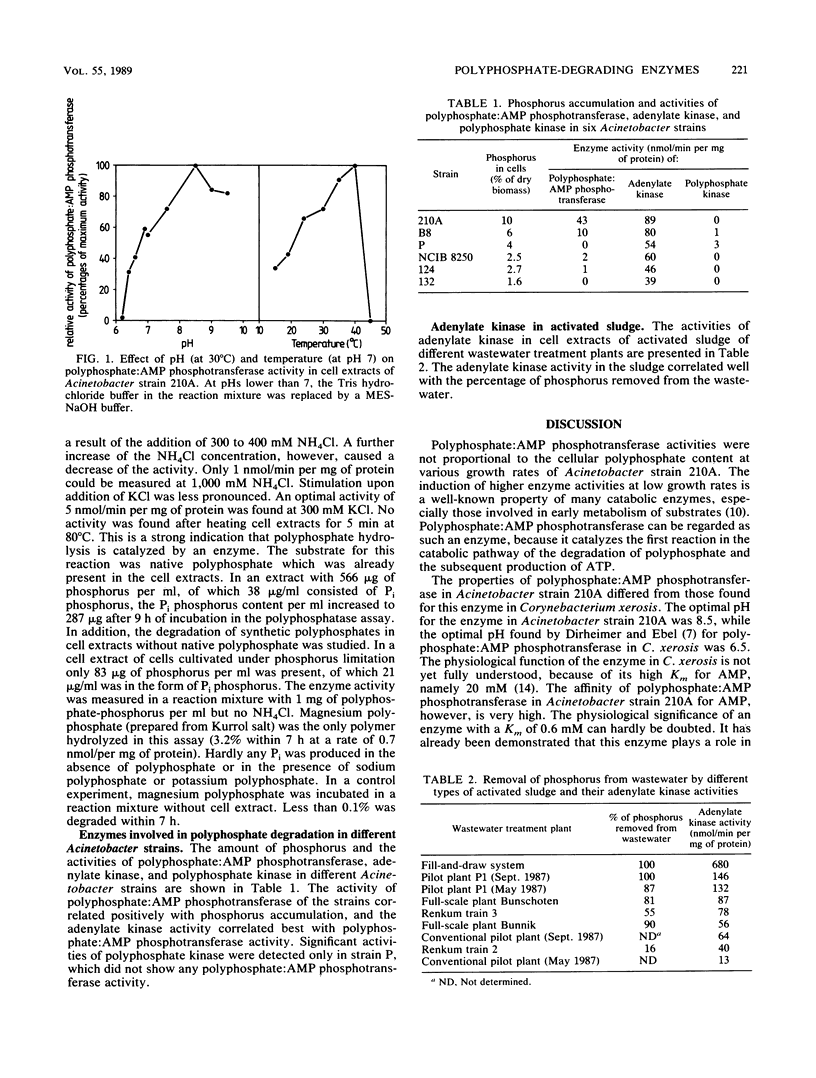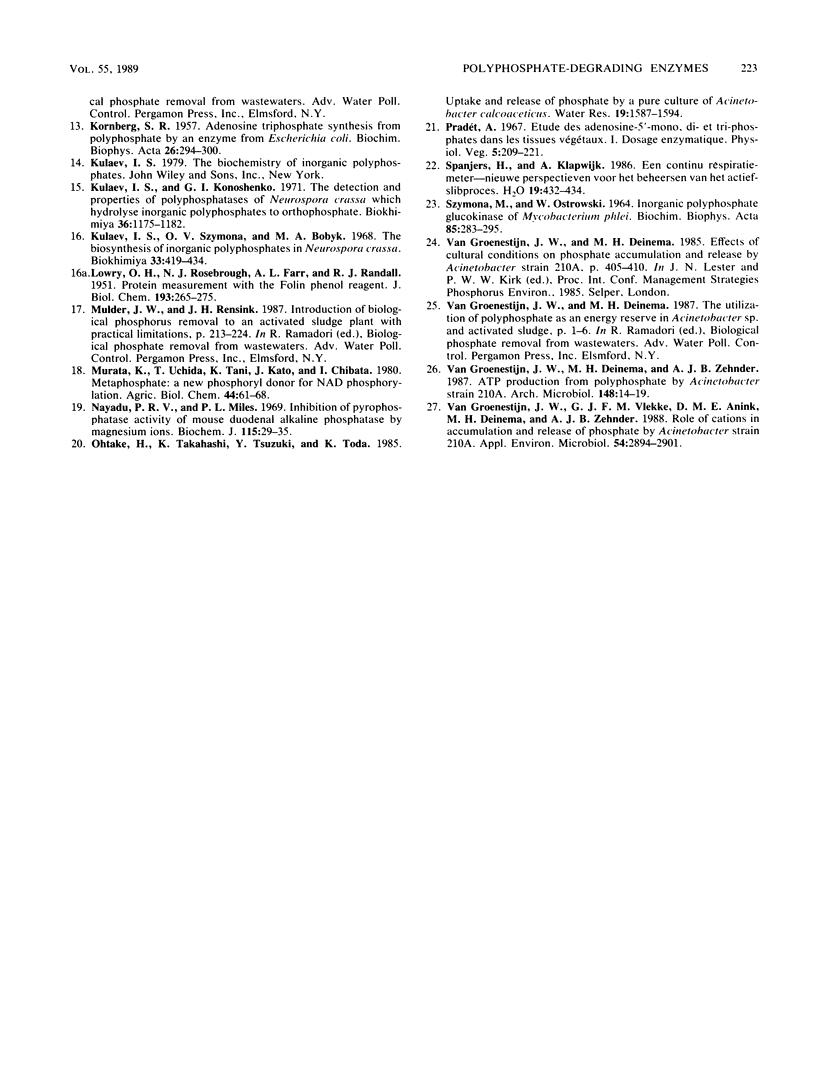Abstract
Polyphosphate-degrading enzymes were studied in Acinetobacter spp. and activated sludge. Polyphosphate: AMP phosphotransferase activity in Acinetobacter strain 210A decreased with increasing growth rates. The activity of this enzyme in cell extracts of Acinetobacter strain 210A was maximal at a pH of 8.5 and a temperature of 40 degrees C and was stimulated by (NH4)2SO4. The Km for AMP was 0.6 mM, and the Vmax was 60 nmol/min per mg of protein. Cell extracts of this strain also contained polyphosphatase, which was able to degrade native polyphosphate and synthetic magnesium polyphosphate and was strongly stimulated by 300 to 400 mM NH4Cl. A positive correlation was found between polyphosphate:AMP phosphotransferase activity, adenylate kinase activity, and phosphorus accumulation in six Acinetobacter strains. Significant activities of polyphosphate kinase were detected only in strain P, which contained no polyphosphate:AMP phosphotransferase. In samples of activated sludge from different plants, the activity of adenylate kinase correlated well with the ability of the sludge to remove phosphate biologically from wastewater.
Full text
PDF




Selected References
These references are in PubMed. This may not be the complete list of references from this article.
- Baumann P., Doudoroff M., Stanier R. Y. A study of the Moraxella group. II. Oxidative-negative species (genus Acinetobacter). J Bacteriol. 1968 May;95(5):1520–1541. doi: 10.1128/jb.95.5.1520-1541.1968. [DOI] [PMC free article] [PubMed] [Google Scholar]
- DIRHEIMER G., EBEL J. P. CARACT'ERISATION D'UNE POLYPHOSPHATE-AMP-PHOSPHOTRANSF'ERASE DANS CORYNEBACTERIUM XEROSIS. C R Hebd Seances Acad Sci. 1965 Mar 29;260:3787–3790. [PubMed] [Google Scholar]
- Feldhau P., Fröhlich T., Goody R. S., Isakov M., Schirmer R. H. Synthetic inhibitors of adenylate kinases in the assays for ATPases and phosphokinases. Eur J Biochem. 1975 Sep 1;57(1):197–204. doi: 10.1111/j.1432-1033.1975.tb02291.x. [DOI] [PubMed] [Google Scholar]
- HAROLD F. M., HAROLD R. L. DEGRADATION OF INORGANIC POLYPHOSPHATE IN MUTANTS OF AEROBACTER AEROGENES. J Bacteriol. 1965 May;89:1262–1270. doi: 10.1128/jb.89.5.1262-1270.1965. [DOI] [PMC free article] [PubMed] [Google Scholar]
- Harder W., Dijkhuizen L. Physiological responses to nutrient limitation. Annu Rev Microbiol. 1983;37:1–23. doi: 10.1146/annurev.mi.37.100183.000245. [DOI] [PubMed] [Google Scholar]
- KORNBERG S. R. Adenosine triphosphate synthesis from polyphosphate by an enzyme from Escherichia coli. Biochim Biophys Acta. 1957 Nov;26(2):294–300. doi: 10.1016/0006-3002(57)90008-2. [DOI] [PubMed] [Google Scholar]
- Kulaev I. S., Konoshenko G. I. Obnaruzhenie i nekotorye svoistva polifosfataz Neurospora crassa gidrolizuiushchikh neorganicheskie polifosfaty do ortofosfata. Biokhimiia. 1971 Nov-Dec;36(6):1175–1182. [PubMed] [Google Scholar]
- Kulaev I. S., Shimona O., Bobyk M. A. O biosinteze neorganicheskikh polifosfatov u Neurospora crassa. Biokhimiia. 1968 May-Jun;33(3):419–434. [PubMed] [Google Scholar]
- LOWRY O. H., ROSEBROUGH N. J., FARR A. L., RANDALL R. J. Protein measurement with the Folin phenol reagent. J Biol Chem. 1951 Nov;193(1):265–275. [PubMed] [Google Scholar]
- Naudu P. R., Miles P. L. Inhibition of pyrophosphatase activity of mouse duodenal lkaline phosphatase by magnesium ions. Biochem J. 1969 Oct;115(1):29–35. doi: 10.1042/bj1150029. [DOI] [PMC free article] [PubMed] [Google Scholar]
- SZYMONA M., OSTROWSKI W. INORGANIC POLYPHOSPHATE GLUCOKINASE OF MYCOBACTERIUM PHLEI. Biochim Biophys Acta. 1964 May 4;85:283–295. doi: 10.1016/0926-6569(64)90249-4. [DOI] [PubMed] [Google Scholar]
- van Groenestijn J. W., Vlekke G. J., Anink D. M., Deinema M. H., Zehnder A. J. Role of Cations in Accumulation and Release of Phosphate by Acinetobacter Strain 210A. Appl Environ Microbiol. 1988 Dec;54(12):2894–2901. doi: 10.1128/aem.54.12.2894-2901.1988. [DOI] [PMC free article] [PubMed] [Google Scholar]


